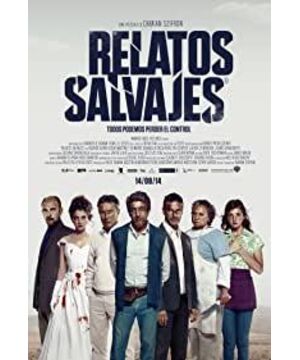When going to the film social history class the year before last, Mr. Thierry Frémaux said that he selected Cannes every year, 15 films, always picking a few stable and experimental or in some ways different. . Relatos salvajes (Relatos salvajes) clearly belongs to the latter. It is a tradition in Cannes to have a comedy to accompany the prince to study every time, and "Savage Story" is the accompany of the prince last year. However, the accompany of the world's number one film festival is not chosen casually. In terms of artistic quality, the sense of picture and narrative of the film are of the first-class standard of drama. Several actors said in interviews that director Damián Szifron often had extremely precise expectations for each shot, not to say that the comic effect of the plot can be given up on the screen. The length of the film is in line with the general trend of today's art films, and it can never be short. The audience seems to have gradually become accustomed to more than two hours of film length. However, unlike "Hibernation" and "The Life of Adele" which took off Palme d'Or in the past two years, "Savage Story" makes people feel the passage of time in the theater: compact, condensed, and attractive. The entertainment film era, which is accustomed to passive acceptance, likes the feeling of being kidnapped by the rhythm of the film. There are no gaps in the narrative process, which completely captures us. This rhythm may be related to the fragment structure of "The Barbaric Story". The whole film is divided into six segments: Pasternak, Las Ratas (mouse), El más fuerte (the strongest), Bombita (small bomb), La Propuesta (proposal) and Hasta que la muerte nos separe (until death separates us). Although the visual style is consistent throughout, there are actually many differences in the subject matter and content. The chief creators also talked about Szifron's too many ideas. Such a structure just uses different ideas, so there is no need to reluctantly give up. [Masters, ghosts, drama bones] Before getting the Oscar nomination last week, the film has two major buying points: Cannes's brightly selected competition film and the production of the Almodova brothers-yes, that's the famous Pedro · Almodovar. In fact, the first producer is Pedro's brother, so how much he has done for the film is a question mark. However, in Szifron's stylized absurdity and cold humor, the influence of Southern European directors such as Almodovar and Dino Risi can be glimpsed. In 2003, Damián Szifron’s feature film directorial debut "El fondo" (El fondo del mar) is a serious drama, some say it is horror, but it also makes sense. In short, the story and narrative are slightly mediocre, not as good as some of his TV works and short films. In 2005's "Tiempo de valientes" (Tiempo de valientes) regained the topic of derailment and betrayal (also in "Savage Story"!), the plot of the detective can also be said to be in the same line as the suspicion in "Under the Sea". The tone of "Savage Tale" is completely different: the director changed his comedy route on the big screen and won the box office champion in Argentina last year. The biggest star in the film is naturally the Argentine drama bone Ricardo Darín. In 2002, he broke out of South America with the Argentine national film Kamchatka. In 2009, he won the Oscar for Best Foreign Language Film (El secreto de sus ojos) )head to the World. Since it is a play bone, the play path is naturally diverse, the most well-known of Darín's comedy works should be the 2011 "Chinese Story" (Un cuento chino). Different from this kind of situational comedic joke, "The Barbaric Story" brings an existential absurdity, a laughing and unpleasant experience. The role of Simón is extremely difficult, because other characters in the film can be used as tragic or comedy facial makeup, only this character is actually a serious drama character. To perform melancholy and humorously on such a sullen character is a great challenge to the director and the actors. [The Absurdity of Hatred] The Pasternak that was unveiled was the shortest of the six clips. It was placed before the subtitles. It condensed the rhythm of every part of the film and prepared the audience for it. From a calm daily scene to the interaction between the characters; as the interaction continues to strengthen, the incredible absurdity appears. Then there was the loss of control of the scene, the fierce chaos and incredible coincidence before the crash made the audience burst into the world of "Savage Story" with a burst of laughter. Pasternak, who has never shown up, is the god of everyone on board at this moment, and holds the power of life and death. He is the perfect metaphor for the clues of the whole drama: mistakes large and small inadvertently provoke hatred, and paranoid revenge brings life into absurd situations. And the fate that arranged all these coincidences is like Pasternak, hidden in everyone's life, you only have a glimpse, but when you look closely, you can't see it. After returning to the ground from the sky, Las Ratas and El más Fuerte provides some real social criticism, which makes people suddenly feel the heaviness of being down-to-earth. The former discusses corruption and justice, while the latter is a hysterical mockery of class relations. The thick and unsharp hatred is still the clue of the story, but it is more specific than Pasternak: death has entered the line of sight from off the screen (the rules of Greek tragedy), and the audience hesitated when they laughed. Beginning with El más fuerte, another mode of the film has also been opened, which is a cry that can be called "I can't bear it anymore". If one of the two female characters in Las Ratas is a symbol of success and tolerance and the other is undisciplined release, then each of the following four clips made great efforts in self-control, but they all failed in the end. Gave an anger. [The absurdity of reconciliation] The absurdity of El más fuerte is the consequence of anger, and in Bombita, the unreasonable life is the cause of the character's outburst. The story starts from surreal or unreal coincidences and edge situations and shifts to the suffocating world of the urban middle class. Every detail about bureaucracy in Bombita seems to be extracted from our own lives, and it is scary. The ancient lessons of stigmatization are still valid in urban life that stigmatizes others' addiction. It is not unreasonable for the director to use his best actor in the fourth segment. Bombita is a turning point for the whole film. The strong hatred began to give way to the failed reconciliation after the hatred. The absurdity of reality is precisely that we cannot control the continuation of revenge, nor can we anticipate the consequences of forgiveness. Bombita opened with trivia and ended with a sensation; La Propuesta opened with human lives, bringing us into the indignation of contempt for life, and then it showed rounds of bargaining. Human life is not only a victim of corruption and power, but also a gambling chip for greed and falsehood. The dignity of the dead is trampled beyond recognition in the game of the living. The charm of its comedy lies in the concretization of the planning process and facial-style corrupt transactions that passed by in the tragedy, and these cruel details are full of absurd nothingness. Everyone in the mansion is working back and forth between the fate of the offender and his own personal interests. Until the husband of the deceased gave the scapegoat a head with iron at the gate, everyone may not think that the victim should be the center of the tragedy. The director revealed in the interview that in the original plan, Bombita was the final piece, as a synthesis and a reconciliation. But in the end I still feel Hasta que la muerte nos The Jewish wedding scene in Separe is more suitable for the final climax, and it is also the most personal segment. If the previous five fragments showed and mocked the unreasonable logic in this absurd world, then the last fragment dispelled all logic, and emotion and impulse finally mastered all the driving force of the plot development. The themes of error, resentment, and revenge resurfaced, but this time they did not sink into a failed reconciliation along a social thread, but dissolved directly in the Bacchus frenzy. The righteous indignation and chest tightness of the first five national hatred and relegation of current affairs were finally released in a completely out of control and absolutely irrational carnival.
View more about Wild Tales reviews










